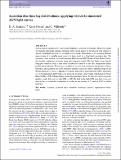Files in this item
Accretion disc time lag distributions : applying CREAM to simulated AGN light curves
Item metadata
| dc.contributor.author | Starkey, David | |
| dc.contributor.author | Horne, Keith | |
| dc.contributor.author | Villforth, C. | |
| dc.date.accessioned | 2016-03-24T17:00:04Z | |
| dc.date.available | 2016-03-24T17:00:04Z | |
| dc.date.issued | 2016-02-21 | |
| dc.identifier | 241582000 | |
| dc.identifier | dff0111f-5707-4fd5-9296-bf5f1ce4635a | |
| dc.identifier | 84960830735 | |
| dc.identifier | 000372264200060 | |
| dc.identifier.citation | Starkey , D , Horne , K & Villforth , C 2016 , ' Accretion disc time lag distributions : applying CREAM to simulated AGN light curves ' , Monthly Notices of the Royal Astronomical Society , vol. 456 , no. 2 , pp. 1960-1973 . https://doi.org/10.1093/mnras/stv2744 | en |
| dc.identifier.issn | 0035-8711 | |
| dc.identifier.uri | https://hdl.handle.net/10023/8482 | |
| dc.description | DAS acknowledges the support of the Science and Technologies Funding Council studentship. KH acknowledges support from the UK Science and Technology Facilities Council (STFC) consolidated grant to St Andrews (ST/M001296/1). | en |
| dc.description.abstract | Active galactic nuclei (AGN) vary in their brightness across all wavelengths. Moreover, longer wavelength ultraviolet-optical continuum light curves appear to be delayed with respect to shorter wavelength light curves. A simple way to model these delays is by assuming thermal reprocessing of a variable point source (a lamp post) by a blackbody accretion disc. We introduce a new method, CREAM (Continuum REprocessed AGN Markov Chain Monte Carlo), that models continuum variations using this lamp post model. The disc light curves lag the lamp post emission with a time delay distribution sensitive to the disc temperature-radius profile and inclination.We test CREAM's ability to recover both inclination and product of black hole mass and accretion rate MM˙ , and show that the code is also able to infer the shape of the driving light curve. CREAM is applied to synthetic light curves expected from 1000 s exposures of a 17th magnitude AGN with a 2-m telescope in Sloan g and i bands with Signal-to-Noise Ratio (SNR) of 500-900 depending on the filter and lunar phase.We also test CREAM on poorer quality g and i light curves with SNR = 100. We find in the high-SNR case that CREAM can recover the accretion disc inclination to within an uncertainty of 5° and an MM˙to within 0.04 dex. | |
| dc.format.extent | 14 | |
| dc.format.extent | 3268105 | |
| dc.language.iso | eng | |
| dc.relation.ispartof | Monthly Notices of the Royal Astronomical Society | en |
| dc.subject | Accretion, accretion discs | en |
| dc.subject | Methods: statistical | en |
| dc.subject | Quasars: supermassive black holes | en |
| dc.subject | QC Physics | en |
| dc.subject | QB Astronomy | en |
| dc.subject | Space and Planetary Science | en |
| dc.subject | Astronomy and Astrophysics | en |
| dc.subject | NDAS | en |
| dc.subject.lcc | QC | en |
| dc.subject.lcc | QB | en |
| dc.title | Accretion disc time lag distributions : applying CREAM to simulated AGN light curves | en |
| dc.type | Journal article | en |
| dc.contributor.sponsor | Science & Technology Facilities Council | en |
| dc.contributor.institution | University of St Andrews. School of Physics and Astronomy | en |
| dc.identifier.doi | 10.1093/mnras/stv2744 | |
| dc.description.status | Peer reviewed | en |
| dc.identifier.grantnumber | ST/M001296/1 | en |
This item appears in the following Collection(s)
Items in the St Andrews Research Repository are protected by copyright, with all rights reserved, unless otherwise indicated.

